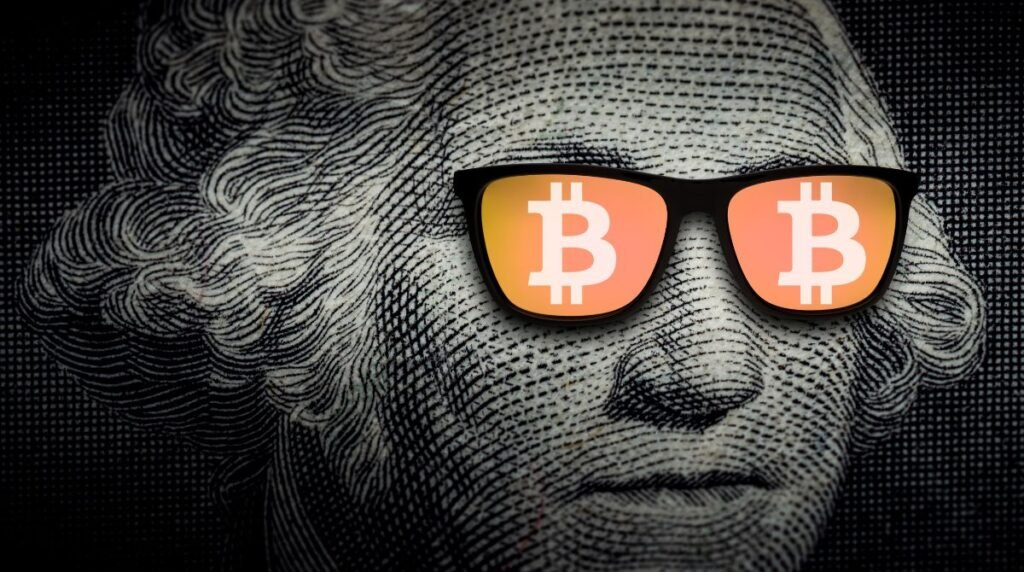Bitcoin is the first and most well-known cryptocurrency. It was created in 2009 by an anonymous person or group of people using the name Satoshi Nakamoto. Bitcoin introduced a new era of digital currency technology, allowing people to send and receive money online without the need for a central authority, like a bank.
In this guide, we will explore what Bitcoin is, how it works, its current value, potential use-cases, its rise in popularity, and how to obtain it.
What we’ll cover
Understanding Bitcoin
Bitcoin is a decentralized digital currency, which means it operates independently of a central bank. Transactions made with Bitcoin are recorded on a public ledger known as the blockchain. This technology is what makes Bitcoin secure and difficult to counterfeit. BTC is the symbol used for Bitcoin, which is often seen in trading and market capitalization listings.
The creation of Bitcoin was aimed at offering an alternative to traditional financial systems. It operates using peer-to-peer technology, enabling users to exchange prices without intermediary processing fees.
Since its launch, Bitcoin has gained immense popularity, often referred to as “digital gold” due to its perceived value.
History of Bitcoin
Bitcoin’s story began in 2008, when someone using the name Satoshi Nakamoto released a whitepaper titled Bitcoin: A Peer-to-Peer Electronic Cash System. This paper outlined a digital currency that worked without banks or governments. In January 2009, the Bitcoin network went live, and Nakamoto mined the first block—known as the Genesis Block.
The first real-world Bitcoin transaction happened in May 2010. A developer in Florida paid 10,000 BTC for two pizzas. At the time, that was worth about $41. This moment is now celebrated as Bitcoin Pizza Day.
As Bitcoin’s value rose, it attracted more users and developers. In 2013, Bitcoin passed $1,000 for the first time. Soon after, interest grew worldwide. But growth came with setbacks. In 2014, Mt. Gox—then the largest Bitcoin exchange—collapsed after losing hundreds of thousands of BTC. This raised concerns about security and trust.
Developers continued improving the network. In 2017, a major upgrade called SegWit increased Bitcoin’s transaction capacity. The same year, Bitcoin Cash split off to form a separate coin with larger block sizes.
Bitcoin hit $20,000 by the end of 2017, dropped sharply in 2018, then reached new highs again in 2021. Institutions like Tesla and MicroStrategy started buying in. Governments and banks also took notice, with some starting to study or regulate it more closely.
Bitcoin ETFs gained approval in some countries, making it easier for traditional investors to gain exposure. As of 2025, Bitcoin continues to be one of the most discussed assets in the world.
The rise in BTC value
The value of BTC has been highly volatile, especially in its early years. Bitcoin started with little to no commercial value, and in the early days, a single BTC could be bought for less than a dollar. However, in the years that followed, its price surged dramatically. Many early adopters became millionaires overnight as the price climbed to thousands of dollars per coin.
Factors that influence BTC value include market demand, media coverage, and regulatory news. Investors often look to Bitcoin as a hedge against inflation and economic instability, which can positively impact its price. Over the years, many investors and institutions have added Bitcoin to their portfolios, further driving demand.
How Bitcoin mining works
Bitcoin mining is how new bitcoins are created and how the network stays secure. It involves solving complex mathematical problems using high-powered computers. When a miner solves a problem, they validate a group of transactions and add them to the blockchain. This group is called a block.
The first miner to solve the problem gets rewarded with new bitcoins. This reward started at 50 BTC per block in 2009. It halves roughly every four years, and is now much smaller. This system is called the halving.
Mining needs special hardware called ASICs (Application-Specific Integrated Circuits). These machines are fast but use a lot of electricity. Because of this, large mining operations often set up in places where energy is cheap.
To make mining more predictable, miners join together in pools. A mining pool combines the computing power of many users and shares the rewards.
The Bitcoin network also adjusts the difficulty of mining every two weeks. If blocks are being mined too fast, it becomes harder to solve the problems. This keeps the network stable.
Bitcoin use-cases
Bitcoin’s role has grown far beyond its early use in online transactions. Today, people and businesses use it in several ways:
Spending and payments
Some online and physical stores accept Bitcoin. Companies like Microsoft and Newegg let you buy products with BTC. You can also use Bitcoin debit cards to convert BTC to local currency and spend it almost anywhere.
Cross-border transfers
Bitcoin helps users send money internationally without high fees or delays. Unlike banks, Bitcoin transactions don’t close on weekends or holidays. This makes it useful for people sending money to family abroad.
Long-term investment
Many see Bitcoin as a store of value, like gold. This idea has led to the term “HODL,” which means holding BTC long-term despite price swings. Some people buy small amounts regularly over time—a method known as dollar-cost averaging.
DeFi and yield earning
Some DeFi platforms let you use Bitcoin to earn rewards. You can lend BTC, earn interest, or use it as collateral for loans. This often involves wrapping Bitcoin on other networks like Ethereum.
Donations and charity
Non-profits now accept Bitcoin as donations. It allows quick and low-fee giving. It also makes it easier for people in restricted countries to support causes they care about.
Microtransactions and content monetisation
Because it doesn’t rely on banks, Bitcoin works well for small online payments. Some websites let users tip creators in BTC. Others use it to charge for content without needing credit cards.
How to get Bitcoin
Acquiring BTC can be done in several ways. One of the most common methods is to buy Bitcoin on cryptocurrency exchanges like Kraken or Coinbase. Users can create accounts, link bank accounts or credit cards, and purchase Bitcoin at current market rates.
For those looking for alternatives, it’s possible to earn Bitcoin for free through Bitcoin faucets.
These are websites that give away small amounts of Bitcoin in exchange for completing simple tasks, such as viewing ads or answering surveys. While the amounts may be small, they can accumulate over time without any investment.
Wallets and storage options
To use Bitcoin, you need a digital wallet. A Bitcoin wallet stores your private keys, which let you access your coins. There are several types of wallets:
- Hot wallets are connected to the internet. They include mobile apps, desktop software, and web-based wallets. They’re easy to use, but more exposed to hacking.
- Cold wallets are offline. They include hardware wallets and paper wallets. These are much safer from online threats.
- Hardware wallets like Ledger and Trezor are physical devices. You plug them into a computer to use them. They’re a good mix of security and convenience.
- Paper wallets are printed pieces of paper with your public and private keys. They’re not as common now but can be secure if created carefully.
For most users, hardware wallets offer the best balance. Always back up your wallet and store recovery phrases in a safe place. If you lose your private key, you lose access to your Bitcoin.
Legal and tax considerations
Bitcoin laws vary by country. In some places, it’s treated as a legal form of payment. In others, it’s restricted or banned. Most governments see Bitcoin as property or an asset.
If you make money from Bitcoin—by selling it, trading it, or spending it—you might owe tax. In many countries, it’s subject to capital gains tax. That means if you buy Bitcoin and it rises in value, the profit is taxable.
Some tax authorities require you to report Bitcoin transactions. This includes income from mining, earnings from faucets, or payments received in BTC.
You may also need to declare if you’re holding a large amount. Some countries have reporting rules for crypto assets over a certain value.
Always keep records of when you buy, sell, or use Bitcoin. This helps with tax filings and shows your transaction history in case of audits.
Long-term predictions and government reserves
Experts have differing opinions on BTC’s future value.
Some believe it could reach new all-time highs as institutional adoption increases, making it a more popular asset for both individual investors and countries. Others warn of potential regulation that may impact its viability.
In any case, it is important to stay informed about developments in the cryptocurrency space.
Some governments are starting to hold Bitcoin as part of their reserves, signaling growing acceptance of cryptocurrency at national levels. As Bitcoin becomes integrated into both everyday transactions and government holdings, its potential impact on the global economy may become even more significant.
FAQs about Bitcoin
What is Bitcoin?
Bitcoin is a decentralized digital currency that allows users to send and receive money directly without intermediaries like banks. It uses blockchain technology to maintain a secure transaction history. Since its inception in 2009, it has become the most recognized cryptocurrency globally.
How can I invest in Bitcoin?
You can invest in Bitcoin by purchasing it on cryptocurrency exchanges, where you can buy it at the current market price. You might also consider using BTC faucets to earn small amounts of Bitcoin for free. Always do your research to understand the risks involved before investing.
What affects Bitcoin’s value?
Bitcoin’s value can be influenced by several factors, including market demand, investor sentiment, regulatory developments, and technological advancements. Media coverage and financial news often play significant roles in swaying public interest and affecting price fluctuations.
Is Bitcoin safe to use?
When used correctly, Bitcoin can be safe. The blockchain technology behind it provides security against fraud and counterfeiting. However, like any investment, it carries risks, including price volatility and regulatory changes. It’s always wise to keep your Bitcoin in secure wallets and to use reputable exchanges when buying.



